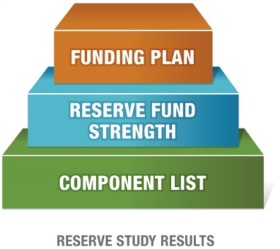“Why do you need to come see our property?” is a typical question asked by new board members when a Reserve Specialist is preparing to conduct a site inspection at a property. This is a fair question that I am happy to answer.
A site inspection is the first step of every “Full” and “Update with Site Visit” Reserve Study. A Reserve Study has 3 key results, as shown below.

Component List Information
As you can see, the first result is the Component List.
Derived from the site inspection, the Component List forms the foundation for the rest of the Reserve Study.
While on a site, a Reserve Specialist looks for components that meet the following four criteria:
- Common Area Responsibility
- Limited Useful Life
- Predictable Remaining Useful Life
- Above a Minimum Threshold Cost
Once the components are narrowed down, the Reserve Specialist is able to assess each individual item based on its appearance and condition.
For example, let’s look at a component such as asphalt. Many associations find it convenient to defer regular sealing and repairing in order save a few dollars. However, during an inspection it will be obvious for a Reserve Specialist to observe the effects of the lack of maintenance.
Heavy cracking, major splitting, and exposed aggregate will all be evident when a street or driveway is at the end of its useful life. The same can be said about the exterior paint on a building. A fresh coat of paint will look clean, bright, and attractive, whereas an old coat of paint on stucco surfaces will most likely have signs of dirt and grime buildup.
The Reserve Specialist needs to make a case for each of the claims that are represented in the Reserve Study. If a Reserve Specialist believes that the pool is in need of resurfacing, then there should be photographic evidence proving that the pool surface is failing as well as detailed notes describing the condition of the pool.
With camera and pen in hand, a Reserve Specialist can make sure that there will be no confusion of the legitimacy of the claims made on the report. A diligent, well planned site inspection will help highlight trouble areas as well as provide clear explanations of the condition of the components.
